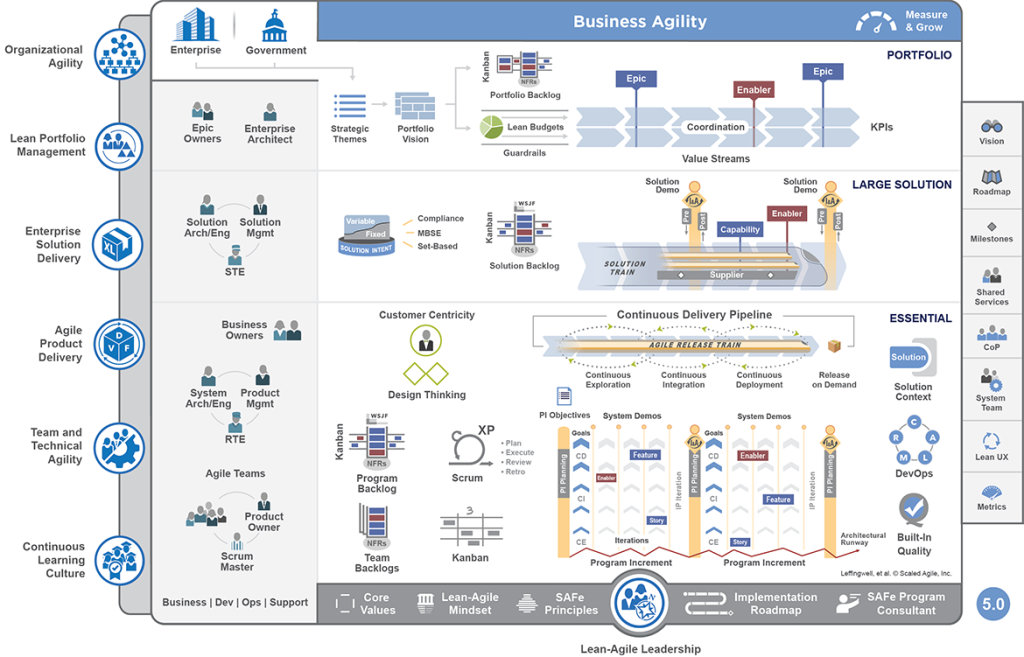In the speedy world of business today, being able to provide top-notch products and services quickly is super important. To make this happen, many companies are using frameworks like SAFe, which stands for Scaled Agile Framework. In SAFe, a special person called a SAFe Agilist has a really important role. Let’s dig into what they do and why they matter so much in making companies agile.
Understanding SAFe:
Before we get into the nitty-gritty of what a SAFe Agilist does, let’s quickly understand what SAFe is. SAFe is a way of doing things that helps companies use agile practices across the whole organization. It helps them work together better, improve teamwork, and deliver things faster. With different roles, events, and stuff like that, SAFe is like a roadmap for making big changes in how companies work.

Meet the SAFe Agilist:
A SAFe Agilist is a super important role in the SAFe framework. They’re like the heroes who help companies become more agile. They do this by making sure everyone understands how to use agile ways of working and by guiding the whole process of change.
What a SAFe Agilist Does:
1. Being the Agile Champion: One big thing a SAFe Agilist does is talk about and make sure everyone understands agile ideas. They help people in the company get why agile is cool and how it can help them work better.
2. Leading Agile Teams: SAFe Agilists help teams work in a more agile way. They give them advice, teach them new things, and show them how to get stuff done faster.
3. Helping Teams Plan: SAFe Agilists also help teams plan their work for certain periods, which they call “Program Increments.” They make sure everyone knows what they need to do and that everyone’s on the same page.
4. Getting Everyone to Work Together: SAFe Agilists bring teams and people together. They help technical teams talk to people who need the things they make. This helps make sure the things being made are what customers want.
5. Always Making Things Better: SAFe Agilists help teams find ways to do things better. They listen to what’s going well and what’s not, and then they help everyone get better step by step.
6. Teaching and Helping: SAFe Agilists are like coaches. They teach and help teams and other people in the company learn how to work better. They’re like the friendly guides who show everyone the way.
7. Keeping Track: It’s important to see how well things are going. SAFe Agilists help figure out what things to measure and how to keep track of them. This helps everyone know if they’re doing a good job.
8. Helping with Change: When a company wants to change how it works, it can be hard. SAFe Agilists help with this. They help teams and leaders understand the changes, deal with any worries, and make everyone excited about the new ways of working.
What Makes a Good SAFe Agilist:
Being a great SAFe Agilist means having certain skills and qualities:
-Knowing About Agile: They need to really know about agile stuff, like how it works and why it’s helpful. This way, they can explain it well to others.
-Being a Leader: SAFe Agilists need to lead and guide others, even if they don’t have a boss title. Leading means helping others do their best work.
-Talking Well: They should be able to explain things in a simple way so that everyone can understand. Good communication helps everyone work together better.
-Being Kind: Understanding others’ problems and being kind is super important. This helps build trust and make people feel comfortable asking for help.
-Always Learning: The way people work is always changing. Great SAFe Agilists keep learning new things so they can stay helpful.
In a nutshell, a SAFe Agilist’s role is super important for making big companies agile. They help teams, leaders, and everyone in between work together better, get things done faster, and deliver awesome stuff. With their guidance, companies can transform and succeed in today’s fast-changing business world.










